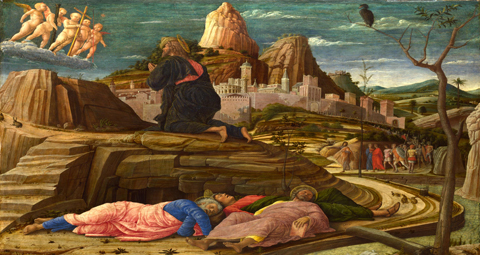April 6 | ![]() 0 COMMENTS
0 COMMENTS ![]() print
print

A Stone’s Throw Away From Everybody
— Fr Ronald Rolhesier
Truth finds us in different ways. Sometimes we learn what something means, not in a classroom but in a hospital.
Several years ago, I was visiting a man dying of cancer in a hospital room. He was dying well, though nobody dies easy. He felt a deep loneliness, even as he was surrounded by people who loved him deeply. Here’s how he described it: “I have a wonderful wife and children, and lots of family and friends. Someone is holding my hand almost every minute, but … I’m a stone’s throw away from everyone. I’m dying and they’re not. I’m inside of something into which they can’t reach. It’s awfully lonely, dying.”
He had borrowed his salient phrase from Luke’s Gospel where we are told that on the night before his death Jesus went to the Garden of Gethsemane with his disciples. There he invited them to pray with him as he struggled to find strength to face his death; but, as Luke cryptically adds, while he sweated blood, he was “a stone’s throw away” from them.
How far is a stone’s throw? It’s distance enough to leave you in a place where no one can reach you. Just as we come out of the womb alone, we leave this earth alone. Jesus, like the man whom I just described, also faced his death knowing that he was loved by others but also knowing that in the face of death he was entering a place where he was deeply and utterly alone.
And this emphasis on aloneness is in fact one of the major points within the Passion narratives. In describing Jesus’ death, perhaps more than anything else, the Gospels want us to focus in on his aloneness, his abandonment, his being a stone’s throw away from everyone.
Many of us, I am sure, have seen the famous film by Mel Gibson, The Passion of the Christ. While the film is, no doubt, a worthy piece of art, it is more distracting than beneficial in terms of helping us understand Jesus’ passion. Why? Because the film so strongly emphasizes the physical suffering of Jesus, which is precisely what the Gospel accounts don’t do. Rather the Gospels deliberately understate what Jesus had to endure physically because they want us to focus on something else, namely, his moral and emotional suffering, particularly his sense of abandonment, his aloneness, the absence at the most crucial time in his life of any deep human support, intensified by the seeming absence of God. In his loneliest hour Jesus was without any human soul mate and without divine consolation. He was, in the words of Gil Bailie, unanimity-minus-one. There is no deeper sense of abandonment.
And it is within that utter aloneness that Jesus has to continue to give himself over in trust, love, forgiveness, and faith. It’s easy to believe in love when we feel loved; to forgive others when they are gracious towards us; and to believe in God when we feel strongly God’s presence. The difficulty, the “test”, comes when human love and divine consolation collapse, when we find ourselves surrounded by misunderstanding, abandonment, distrust, hatred, and doubt, especially at our loneliest hour, just at that moment when life itself is eclipsing. How do we respond then?
Will love, trust, forgiveness, and faith collapse in our hearts when the emotional pillars that normally sustain us collapse? Can we forgive someone who is hurting us when that person believes that we are the problem? Can we continue to love someone who hates us? Can we continue to believe in trust when everywhere around us we are experiencing betrayal? Can we let our hands and hearts be opened, stretched, and nailed to a cross even when we are fearful? Can we continue to have faith in God when every feeling inside us suggests God has abandoned us? Can we still hand over our spirit when we feel absolutely no human or divine support? Where are our hearts when we are “a stone’s throw away” from everyone?
That, and not the capacity to physically endure scourging and nails, was the real test inside of Jesus’ passion. Jesus’ agony in the Garden was not so much an agonizing as to whether he would allow himself to be put to death or whether he would invoke divine power and escape. He recognized that he was going to die. The question for him was rather how he would die: Could he continue to surrender himself to a God and to a truth he had previously known when this now seemed to be belied by everything around him? Could he continue to trust? What kind of spirit would he hand over at the end? Would it be gracious or bitter? Forgiving or vengeful? Loving or hate-filled? Trusting or paranoid? Hope-filled or despairing?
That will be our test too in the end. One day each of us will also have to “give over” his or her spirit. Inside of that unanimity-minus-one, will our hearts be warm or bitter?











